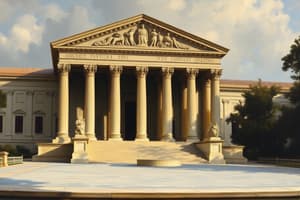Podcast
Questions and Answers
What types of cases fall under the original jurisdiction of the Supreme Court in the United States?
What types of cases fall under the original jurisdiction of the Supreme Court in the United States?
- Cases affecting ambassadors or other public ministers
- Disputes between states
- Cases where a state is a party
- All of the above (correct)
What is the primary role of the Supreme Court in the United States?
What is the primary role of the Supreme Court in the United States?
- Executing federal policies
- Interpreting the U.S. Constitution (correct)
- Drafting federal laws
- Appointing federal judges
In the U.S. judicial system, what is appellate jurisdiction?
In the U.S. judicial system, what is appellate jurisdiction?
- The power to enforce federal laws
- The power to create new laws
- The power to appoint judges
- The power to review decisions of lower courts (correct)
How are justices appointed to the Supreme Court in the United States?
How are justices appointed to the Supreme Court in the United States?
Which type of federal court hears most federal cases in the United States?
Which type of federal court hears most federal cases in the United States?
When can the U.S. Supreme Court decide to hear cases in its appellate jurisdiction?
When can the U.S. Supreme Court decide to hear cases in its appellate jurisdiction?
What differentiates original jurisdiction from appellate jurisdiction in the U.S. judicial system?
What differentiates original jurisdiction from appellate jurisdiction in the U.S. judicial system?
Which branch of the U.S. federal government is responsible for interpreting the Constitution and ensuring its relevance in modern society?
Which branch of the U.S. federal government is responsible for interpreting the Constitution and ensuring its relevance in modern society?
What role does the Supreme Court play in the U.S. federal government's system of checks and balances?
What role does the Supreme Court play in the U.S. federal government's system of checks and balances?
What is the primary purpose of judicial review in the American constitutional system?
What is the primary purpose of judicial review in the American constitutional system?
Flashcards are hidden until you start studying
Study Notes
Judicial Branch and Jurisdiction
The judicial branch, as a cornerstone of the United States government, plays a vital role in our legal system. It interprets and applies the law, and its tribunals resolve legal disputes. Central to the functioning of the judicial branch is the concept of jurisdiction. In this article, we'll explore the judicial branch's overarching structure, focusing on the Supreme Court, appellate jurisdiction, original jurisdiction, federal courts, and the nuances of original versus appellate jurisdiction.
The Supreme Court
The Supreme Court is the highest court in the United States, with final authority on interpreting the U.S. Constitution, federal laws, and treaties. The Supreme Court also decides cases involving state governments when there is a conflict with federal law. The court is composed of nine associate justices, who are appointed by the President and confirmed by the Senate, serving for life unless they retire, resign, or pass away.
Appellate Jurisdiction
Appellate jurisdiction refers to the power of a court to review the decision of a lower court on appeal. In the U.S., the appellate jurisdiction of the Supreme Court is limited. It can decide to hear cases only if they are granted a writ of certiorari, which is a discretionary tool that provides the Court with the power to review the precedent-setting decisions of federal courts of appeals, federal district courts, and state supreme courts.
Original Jurisdiction
Original jurisdiction refers to the power of a court to hear cases from the very beginning. In the United States, the Supreme Court has original jurisdiction in only a few limited circumstances, such as disputes between states, cases affecting ambassadors or other public ministers, and cases in which a state is a party.
Federal Courts
The federal court system in the United States is made up of three types of courts: district courts (the trial courts), courts of appeals, and the Supreme Court.
- District Courts – There are 94 federal district courts, which hear most federal cases. Cases from federal district courts can be appealed to one of the 13 U.S. Courts of Appeals.
- Courts of Appeals – There are 13 U.S. Courts of Appeals, which hear appeals from the district courts. Cases from the Courts of Appeals can be appealed to the Supreme Court.
Original vs. Appellate Jurisdiction
The distinction between original and appellate jurisdiction is crucial for understanding the role of the Supreme Court and the federal court system. While original jurisdiction allows the Supreme Court to hear cases from the beginning, appellate jurisdiction allows the Supreme Court to review decisions of lower courts. Original jurisdiction is limited in the Supreme Court, which primarily exercises appellate jurisdiction, meaning it hears appeals from lower courts.
In summary, understanding the judicial branch and jurisdiction is essential for navigating our legal system. The Supreme Court is the highest court of the land, while appellate jurisdiction and original jurisdiction are two critical concepts defining the court's powers. Federal courts comprise the district courts, courts of appeals, and the Supreme Court. The distinction between original and appellate jurisdiction helps us understand the role of the Supreme Court and the federal court system in the United States.
Studying That Suits You
Use AI to generate personalized quizzes and flashcards to suit your learning preferences.




